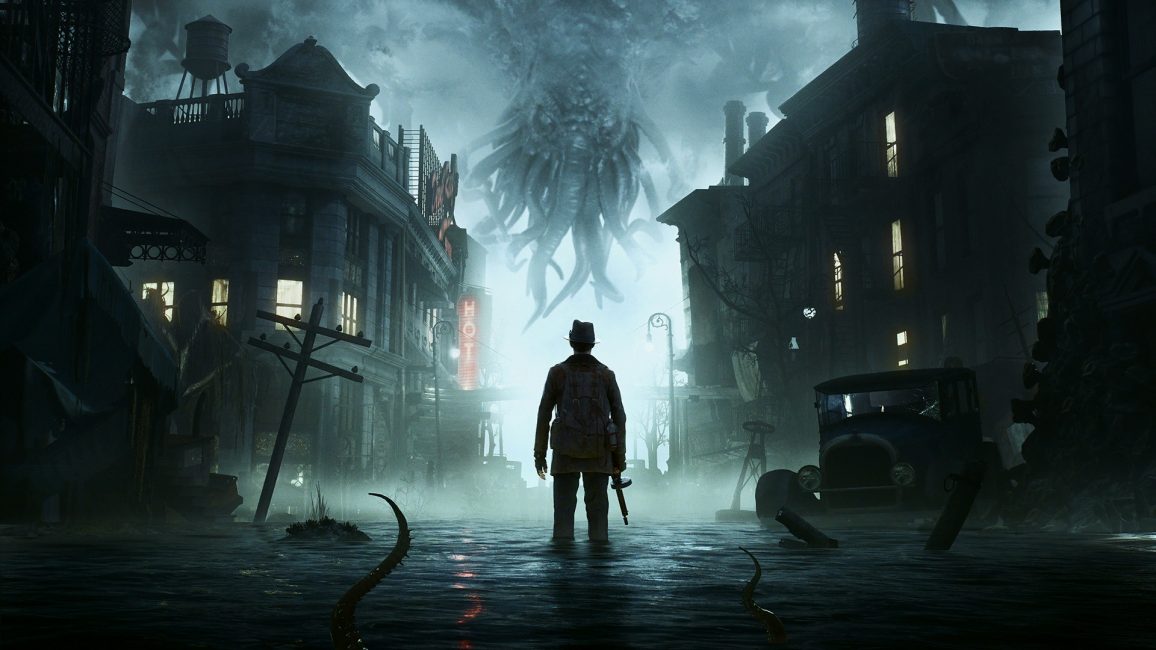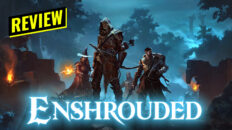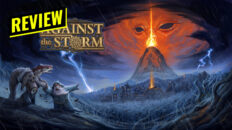Developer: Frogwares
Publisher: Bigben Interactive
Reviewed on: PlayStation 4 Pro
Code Received.
The Sinking City takes place in the fictional New England city of Oakmont during the 1920s. The city has been mysteriously flooded by not only water, but also psychosis. Many streets have turned into rivers and the citizens are suffering from horrible visions, causing violent outbursts and a town on the edge of madness. As Charles Reed, a private detective from Boston, you arrive in Oakmont to investigate the cause of the visions, which you also suffer from. During your investigation you discover a dark, supernatural power is the source of the city’s duress. Reed must navigate the delicate politics of the city while uncovering, and hopefully stopping, the spread of the madness, saving himself and the city in the process.
The setting and story is by far the most interesting aspect of The Sinking City. The mystery of the city of Oakmont and the various factions that inhabit it are presented front and center. Most of this will be worn territory for those familiar with H.P. Lovecraft’s work, but still the presentation here is genuine and raw. Oakmont is not only ravaged by madness and natural disaster, but also racism and prejudice. Reed’s primary contact is Robert Throgmorton, a half-human, half-ape man of considerable wealth. He uses his wealth and power to fund research into the bizarre events that have befallen the city, as well as the University Library because “people need education and entertainment.” All the while, he allows the poor to go hungry, mad, and murder each other. His lack of charity to the poor is rooted in his prejudice towards the Innsmouthers, a race of immigrants that are half-fish and half-human. The Innmousthers coincidentally arrived in Oakmont around the same time the disasters befell the city, so the residents often blame them for their hardships.
There is a clear parallel here between not only modern issues around immigration, but also immigration at the time the game is set. Frogwares chose to tackle the metaphors Lovecraft used in his works, going so far as to outline their reasoning in a developer message shown every time you launch the game. Throgmorton’s bigotry is obvious, he holds all Innsmouthers accountable for the actions of a few. Blaming them for their own impoverished circumstances without realizing his role in enabling the hardships they endure. As Reed you are offered opportunities to not only subvert his prejudice, but also call it out to his face. It’s a refreshing layer added onto the typical cosmic horror, occult imagery you get from Lovecraft-inspired works, and is generally handled well.

Reed must dig deep into the culture and history of Oakmont to get to the bottom of the madness, so he parlays his detective skills to help residents with their problems, opening up new avenues for his primary investigation. If you are familiar with Frogware’s Sherlock Holmes mystery games, the process of solving a case is similar, if a little watered down. You must question citizens, investigate crime scenes for clues, then put the clues together to form deductions. The game keeps track of all the relevant information for you, and all you really need to do it is put two clues together to form a conclusion. Often times you are presented with multiple interpretations of the same evidence, and you can choose which to present as the “truth”. This process is fascinating on the surface, but begins to become rote as you repeat the same process for each investigation and learn the choices you make are largely superficial. Combine that with stiff player controls and sometimes long, uneventful walks to key locations, and the whole process becomes a chore.
In addition to the investigation mechanics, the game also offers completely unnecessary and clunky combat. These moments offer nothing in terms of challenge or tension. Instead, it’s more of a fight with unresponsive aiming and enemies that constantly dodge your bullets or aborb them as if immune. These moments are exasperated by the limited amount of ammunition in the game, often requiring you to run instead of fight. However, this strategy doesn’t work well when the house you have to investigate is infested by monsters. It leads you to cheesing the abysmal enemy AI into situations that put them at a disadvantage. Combined with a complete lack reaction from the main character in regards to sometimes murdering people in their own homes, and the combat really comes off as unnecessary, unpolished, and frustrating.
Reed’s lack of reaction to just about everything he sees and does in the open-world portions of The Sinking City underscore the game’s failure to execute on its own ambitions. You’ll run down street after street with dozens of citizens milling about, but making almost no sound. No idle conversations, no noises aside from overlapping footsteps, just crowded, yet completely silent sidewalks. NPCs will pop in in front of you, often piling on top of each other as their AI routines are triggered. Character models repeat constantly. All the streets look the same, with rusting husks of cars and tall grey apartment buildings. As boring and uneventful as boating around on the flooded streets can be, it’s at least a welcome respite from hoofing it, mostly because of it’s novelty. You’ll be seeing these shortcoming often because most investigations require you to fast travel to many of the same locations to uncover the evidence needed to progress.

Now we come to the biggest crime of all, the game’s technical performance. Throughout most of my playthrough the game dipped well below a reasonable framerate. I don’t have actual numbers, but it frequently felt like it dropped to 10-15 frames per second. This was mostly common when running through the open streets of Oakmont, where large amounts of the city would load and pop in as I made my to my destination. But it also occurs inside buildings as well, so it’s not really clear what is causing the game to chug. The framerate drops are a nuisance at best, but a frustration when they crop up during combat.
The Sinking City is a an interesting story bogged down by unnecessary additions that are executed poorly. The setting, lore, characters, and cultural politics of the city of Oakmont are extremely fascinating and are often explored in-depth. The way all the various factions must continue their lives in a world drowned in water and madness may be enough to pull you through the shallow gameplay mechanics and lifeless open-world. However, the novelty of the investigation system wears off too early, devolving into repetition. The attempts to break up the investigations with combat just further exemplifies the game’s failure to execute on its own ambitions. Untimely, these shortcoming hindered my enjoyment of the story, resulting a disappointing slog through the murky depth of Oakmont.









